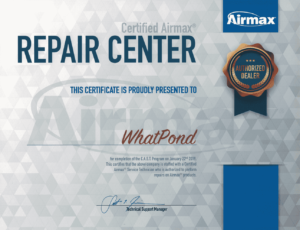Managing Pond Weeds: Your Pond Toolbox
Posted on Mother Earth News, link at bottom.
OK, let’s get into the different tools to manage our pond weeds.
The cheapest tool is our hands. Just like weeding the garden or flower bed, we can do the same in the pond to keep areas clear of weeds, manage areas we want clear and remove the mass, or biomass, of weeds before winter sets. Fall is a good time for this, because we want to get the weeds out before seeds drop and the weeds are strong, not decaying like they would be in spring.

Looking at tools we can use to clean, cut, remove and even kill weeds will help our hands a bit and get the job done a little faster, but it’s still going to take some work cutting the weeds and removing them from the pond.
Aquatic Tools for Pond Management
Aquatic weed cutter is a tool that comes with a two-piece handle, making the total cutter reaching out to 11’ from shore to be tossed in the pond and pulled back to shore in a jerking motion, cutting weeds along the way with a 28” wide pass. Some weeds will be cut and some of the weeds will entangle around the cutter. After a couple passes, you’ll see the difference the cutter has made and the weeds that have been cut will be floating on the water, don’t worry about them yet. The next tool takes care of the cut floating weeds.
 The floating rake would then be used to toss out into the pond to retrieve the floating weeds that have been cut. You can even take the float off the rake to let the rake sink to the bottom and pull the rake in to capture partially cut weeds still attached at the bottom of the pond. The floating rake also has an 11’ handle and 36” wide pass. Plus, the rake comes with a 20’ length of rope to be able to reach farther out in the pond. The rake and weed cutter can be a great pair of tools for the pond toolbox to manage the weeds, keeping a fishing lane open or getting the mass of potential muck out of the pond before it ends up decaying.
The floating rake would then be used to toss out into the pond to retrieve the floating weeds that have been cut. You can even take the float off the rake to let the rake sink to the bottom and pull the rake in to capture partially cut weeds still attached at the bottom of the pond. The floating rake also has an 11’ handle and 36” wide pass. Plus, the rake comes with a 20’ length of rope to be able to reach farther out in the pond. The rake and weed cutter can be a great pair of tools for the pond toolbox to manage the weeds, keeping a fishing lane open or getting the mass of potential muck out of the pond before it ends up decaying.
This next tool floats along the top surface of the pond, and can be great to remove the algae mats, duck weed and floating debris. The tool is called the Deskuzzer: Picture a floating net or basket which is tossed out on the water and pulled back to shore slowly to capture the floating debris. Once on shore, simply turn the basket to the side and let the debris slide out and repeat until the area is cleaned up. I do like this tool as it is 5’ wide taking a bigger pass than the rake and includes a 24’ rope for retrieval. The weed cutter, floating rake and Deskuzzer all run around $130 each.
I’m sure by now you see these tools can great be a workout depending on the amount of weeds that need to be managed and how dense the affected area is. Our next tool to look at is a little less work; you’ll need a boat to place it which is the easiest way but if the pond is small you could use ropes from one side to the other.
 Lake Bottom Blanket, standard width of 10 ¾’ and start at 20 foot in length with 5 foot increments up to 50’ long. This special pond tool method of action is to cover the weeds and block out sunlight which in effect takes the photosynthesis out of the picture robbing the plant of its source of growth. The Lake Bottom Blanket is made in a special way that it does not suffocate the bottom of the pond and allows a little breathing room for small bottom critters. Holes in the blanket allow for gasses to escape through the blanket and does not end up ballooning to the surface as some knock offs do.
Lake Bottom Blanket, standard width of 10 ¾’ and start at 20 foot in length with 5 foot increments up to 50’ long. This special pond tool method of action is to cover the weeds and block out sunlight which in effect takes the photosynthesis out of the picture robbing the plant of its source of growth. The Lake Bottom Blanket is made in a special way that it does not suffocate the bottom of the pond and allows a little breathing room for small bottom critters. Holes in the blanket allow for gasses to escape through the blanket and does not end up ballooning to the surface as some knock offs do.
Packaging and care has been thought out in the manufacturing of the blanket. Cool features like the sewn-in pockets for re-bar, one end is sewn to trap the re-bar from slipping out and the entry end and a wire tie in place to seal that end. End caps for the re-bar are also included to cover up the sharp edges of the cut re-bar so it doesn’t cut the blanket. Rope handles are attached at both ends and come with extra rope for each end, one to tie on to shore and the other to attach to the included float that marks the end of the blanket.
The Lake Bottom Blanket is even packed so when it unfold,s the pockets for re-bar are all in one place. Leave the blanket in that position, install the re-bar, tie up the zip ties and boat or pull it out into the pond. Pricing starts at $150 for 10′ x 20′, but remember you’ll need to purchase re-bar locally. Find it locally to save on shipping, hardware stores or places that make cement.
Powered pond tools are helpful too but can be a little expensive. Starting off with a handheld tool similar to a weed whacker. The head does not spin around but rather reciprocates back and forth to cut the weeds, even cattails. A regular weed whacker, if you have not tried one in the water, will simply get you wet, stalls out and if trimming around the edge of the pond throws the cut weeds into the pond adding more biodegradable nutrients and muck. The tools is called the Red Max Reciprocator, it is possible to find used ones, but the new price is around $680.00
Next up is the Lake Mower. This is a 4’ wide sickle bar that attaches to you small boat and run on a battery. There add on extensions to reach deeper depths so you may only need to cut once per season but that depends on the type of weed being controlled. The Lake Mower does save a lot on the back but you will still need to get all the cut weeds out of the pond and the Lake Mower folks build a rake to attach to the boat to do just that. Push the weeds to shore then have folks fill the truck from there. Speed on cutting is about the same as a push mower. Cost varies but for the machine and a 2’ extension to reach 7’ deep, you would be looking at close to $3,000.
Evaluate Your Pond Needs First
As you can see, there are various tools to manage the plants and weeds in our pond, different price points and different levels of labor involved. Do you need to be weed-free? A lot depends on your preference and the use of the pond. A weed free pond has an effect on the fish, where can they hide, where can they ambush from? Same with too many weeds chocking out the pond now they can hardly see to move around, easier to hide from their predators and even seems to be stunt their growth.
If submerged, weed reaches the surface of the pond, and it does become unattractive and that would be the signal to start weeding out the pond. If the pond is covered or very densely populated with weeds but not at the surface it is a good time to clear out some areas where the fish have some open water creating hard a line between the vegetation and clear areas for place to hide from the predator and a place for the predator fish.
The main weeding events can be spring and fall to get the mass of vegetation out of the pond before it becomes a decaying mass at the bottom of the pond, eventually turning to muck. Then look at summer for control, improving the looks of the pond and creating open areas for the fish.
Just to be upfront about using the weed cutter, rake and Deskuzzer is hard work of repeated use of the tools. Using the power type cutters like the Red Max and Lake Mower you do get a break on the cutting part of the job but still need to get the weeds out of the pond. The Lake Blanket seems a little more attractive with a lot less physical labor.
Aeration and Beneficial Bacteria
Much and sludge builds up in the pond over time, this is the smelly black stuff that oozes between your toes. This is also the food source for algae and weeds, a rich mix of decaying debris acting like fertilizer. With the proper aeration and beneficial bacteria we can reduce the muck and food for the weeds and algae need to grow. Not all weeds or plants are the same, some have shallow roots into the muck but other species could be rooted in the subsurface of the pond floor which would be harder to get rid of in these processes mentioned in this article. Check out our Beneficial Bacteria packets or pellets. Learn more about proper aeration.

